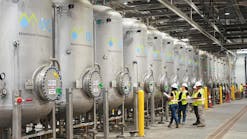• Enables waste stream to produce energy; Shows potential for other wastewater treatment and energy applications
ANAHEIM, CA, Jan. 26, 2009 -- Catalyx Inc. has successfully piloted its patent-pending Two-Way Osmosis (TWO) system for recycling of difficult to treat, high biochemical oxygen demand (BOD) and high chemical oxygen demand (COD) carpet dyeing wastewater. The system utilizes a unique membrane to employ the Forward Osmosis concept (a pressure free water transport mechanism also used by plant roots) combined with the more common reverse osmosis concept.
Carpet and textile dyeing mills use copious amounts of water in their dyeing operations. In many areas, the shortage of fresh water is hampering operations. Conventional nanofiltration and/or reverse osmosis membrane equipment requires very high levels of chemical pre-treatment of the wastewater to remove the synthetic and natural oils which foul membranes, creating a chemical-laden concentrated waste stream after the water is removed. The Catalyx TWO system can treat the water streams without chemicals, enabling the concentrated wastewater that is rich in organics to be incinerated in a boiler or anaerobically digested to produce biogas.
Nature uses forward osmosis to transport water throughout living organisms such as plants and animals. Commercial reverse osmosis membrane systems do the opposite -- deriving pure water from saltwater. Reverse osmosis applies very high hydraulic pressure on the saltwater to extract pure water -- against the water's natural tendency. These membranes cannot operate in the forward osmosis mode because they have to be built to withstand such pressures.
Reverse osmosis pressure pushes the fouling contaminants against the membranes and causes degradation in performance, and increase in operating costs. Thus state-of-the-art membranes have largely been excluded when it comes to high organic, fouling content wastewater.
Mr. Juzer Jangbarwala, Catalyx Inc. inventor and founder stated, "Our vision is to practice 'subtraction' while treating water, instead of 'addition' of chemicals, as is typically done in the treatment of high organic waste. By concentrating the waste through simple water subtraction, it opens up new possibilities, such as reclaiming the process chemicals and generating biogas from the organics."
Jangbarwala noted, "While the eventual goal at Catalyx is to design a system which can utilize this unique membrane for desalination of seawater, we are currently only focused on the system's ability to dewater very difficult to treat wastewater."
Catalyx has successfully tested the TWO system for other applications, including concentration of ion exchange waste by 50% at a coal bed methane (CBM) produced water treatment plant, recycling tannery wastewater, and concentrating animal farm wash water and landfill leachate water to enhance biogas production.
The core Forward Osmosis technology of the TWO systems will be especially valuable for offshore facilities and ships. It has been successfully tested to reduce "bilge" water volume from ships, using seawater as the draw solution, and no power input. Similarly, Catalyx believes it will be very successful in enhancing treatment efficiency of process and sewage wastewater on off shore oilrigs.
Jangbarwala added, "Osmotic pressure is a source of energy, and the differential can be used to either convert that energy to electricity or as a tool for energy storage. An exciting possibility with our unique membrane is to build an 'energy storage' system for offshore windmills. High winds are not always synchronized with the grid requirements. During the high wind periods, we could desalinate seawater using the excess electricity, and during low winds, allow the osmotic pressure differential between seawater and the desalinated water to generate electricity and feed the grid."
>> Additional technical background on the forward osmosis process [Navigate to Technology >> Wastewater Treatment >> Forward Osmosis]
Catalyx Inc. is a privately funded technology incubator founded in 2002. For six years, it has been involved in the development of low cost, sustainable technologies for distributed renewable energy generation, green manufacturing processes and water treatment technologies.
###


